Comparison Chart: Best Audio Interface for Guitarists
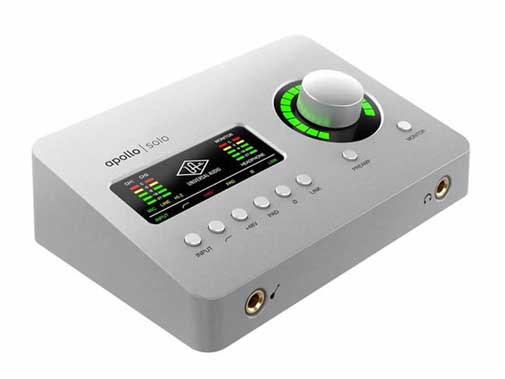
Pros
- Preamps have the best dynamic range on this list (tied with Clarett 2Pre)
- Coveted UA Plugins included
- Direct monitoring
- Real-time effects processing
- Fantastic overall performance
- Recent price-drop
Cons
- No thunderbolt cable included
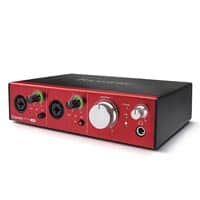
Pros
- Mic inputs have the best dynamic range on this list (tied with UA Apollo Solo)
- very low noise shelf on preamps
- Excellent included plugins
- Real-time effects processing
- Direct Monitoring
- Can be used as a stand-alone preamp for live performance
Cons
- Some distortion on the headphone output when used with low impedance headphones.
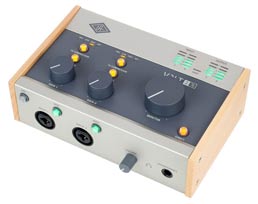
Pros
- Built-in compression
- Price
- Direct monitoring
- Can be used with IOS devices
- External power supply option allows you to use it as a stand-alone unit for live performance
Cons
- No real-time effects monitoring
- Higher round-trip latency than others on this list
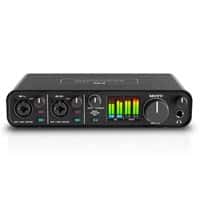
Pros
- Direct monitoring
- Price
- Simple set-up, almost everything can be controlled from the interface itself.
- Great overall performance with excellent dynamic range on the mic inputs
Cons
- No real-time effects monitoring
- Included software is nothing special
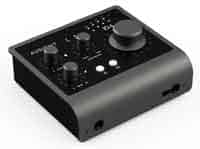
Pros
- Price
- Low round-trip latency
- Competitive technical specs
- Quality build
Cons
- No direct monitoring
- No real-time effects processing
- Included software is nothing special
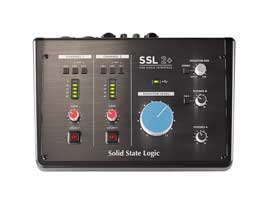
Pros
- Warm, clean response from the preamps
- Great Build
Cons
- No direct monitoring
- Average latency
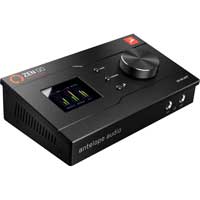
Pros
- Bountiful supply of included high-quality plugins
- Real-time effects processing
- High-quality AD/DA converters
Cons
- Audible noise floor on the preamps
- Price
Criteria: Best Audio Interface for Guitarists
In our testing and rating of audio interfaces for guitar, we were looking for the following qualities:
- The ability to directly monitor your performance (and better yet, the ability to monitor effects and plugins with real-time processing)
- Enough power from the headphone output to drive high-impedance headphones
- Sufficient dynamic range from the preamps to support gain-hungry mics (e.g. dynamic mics like the Shure SM7B)
- Line inputs with low distortion and sufficient dynamic range
- Low noise shelf from the preamps
- Minimal round-trip latency
- Uncolored, transparent sound from the main outputs and headphone outputs. For more info on Headphones for Guitar, see here.
We shortlisted the seven interfaces below and thoroughly tested them. We test everything on this site ourselves.
About the Audio Tests
We have provided audio examples from our tests below. The guitar examples use a Fender Stratocaster plugged directly into the interfaces with the same amp plugin (Amplitube Fender 65 Super Reverb).
We also provided spoken word using a Neumann TLM 102 with no compression or EQ to give an idea of the raw sound of the preamps. The text is from the Mad Gardener’s Song by Lewis Carroll.
See here for all our audio gear reviews and features.
Universal Audio Apollo Solo
our rating
5.0
Bottom Line:
Our favorite on this list. Excellent technical performance, real-time effects processing, direct monitoring, and a recent price-drop.
Hardware & Software
The Universal Audio Apollo Solo is a 2-in/4-out, audio interface with excellent included plug-ins and real-time effects processing. This unit is one of our favorite interfaces on the market.
The interface is all metal with an LED display for checking levels. It works with the UAD Console software where plugins can all be pre-baked into the recorded sound and monitored in real-time.
Inside the unit are high-quality chips for DA/AD conversion and DSP support. The solo is limited in its DSP (Digital Signal Processing). You can only get about three plug-ins to run at the same time. If you need more power consider the Apollo Twin X.
Inputs and Outputs
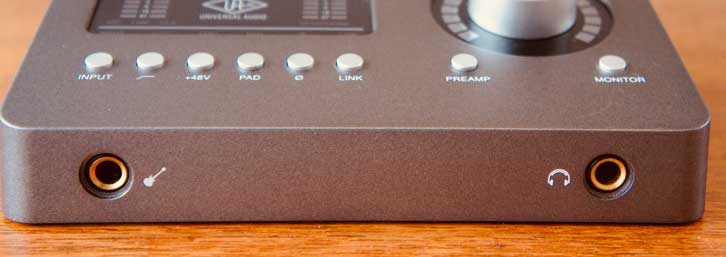
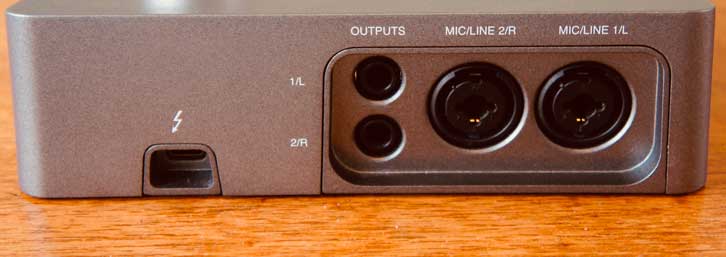
The UA Apollo Solo has the following inputs and outputs:
- 2 XLR/TRS combo jacks for mic, line, or Hi-Z inputs
- 1 JFET instrument input
- 2 1/4-inch TRS balanced outputs (stereo pair)
- 2 1/4-inch TRS stereo headphone outputs (front)
- 1 USB-C/Thunderbolt 3 port
Performance
The Universal Audio Apollo Solo delivers technical performance that outdoes or holds par with all interfaces in its class.
The preamps deliver a 118 dB dynamic range (highest on this list tied with Clarett 2Pre) with a completely inaudible noise shelf.
With monitoring running through UA Console, you will get near-zero latency on all effects. Keep in mind, these effects are all limited by the DSP of the interface (about three at a time can be applied, maximum).
If you want to monitor through your DAW and hear all the plugins from the channel strip, the Apollo Solo delivers minimal round-trip latency (depent on the buffer size you use).
The line input, main output, and headphone inputs all have minimal distortion.
The headphone output can drive all high and low-impedance headphones with ease, all with very low distortion.
Audio Examples
Strat, DI – UA Apollo Solo
Spoken Text – UA Apollo Solo
Verdict
In our opinion, the Universal Audio Apollo line interfaces are some of the best you can buy. With fantastic overall performance, some of the best plugins out there, and the ability to monitor your effects with near-zero latency, we can highly recommend the Apollo Solo.
The price of this unit has dropped considerably since its release. With the lower price, it’s a no-brainer.
Focusrite Clarett 2Pre
our rating
4.8
Bottom Line:
A step up from the Scarlett line. An interface with plenty of channels for larger projects, excellent dynamic range, and overall performance.
Hardware & Software
The Clarett 2pre is a 10-in/4-out interface, with a solid, durable build. The unit can be powered using either USB-C or the 12V AC cable. Using the AC cable allows you to use the interface as a stand-alone preamp to shape your sound before you send it to a PA in live performance.
The unit has a metal face, metal dials, and hard plastic housing. With just green, orange, and red glow on the gain dials, the level meters are not particularly helpful.
Buttons on the front include Focusrite’s ‘Air Mode’ which alters your frequency response, giving you a 4 dB bump in the high frequencies and 2 dB in the high mids.
The ADAT optical input allows you to add another 8 channels for larger projects, giving you some room to grow with this machine.
Inputs and Outputs
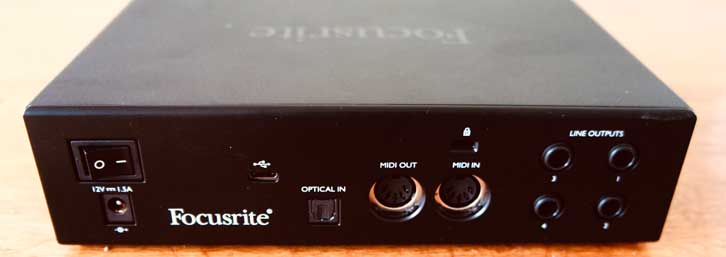
The Focusrite Clarett 2pre has the following inputs and outputs:
- 2 XLR/TRS combo jacks for mic, line or Hi-Z inputs (front)
- 4 1/4-inch TRS balanced outputs
- 1 optical input
- 1 1/4-inch TRS stereo headphone output.
- 1 MIDI I/O
- 1 USB-C port
- 1 12 V power port
The included software has three high-quality plugins: the Brainworx bx_console, and the Red 2 and 3 EQs and Compressors.
With the Clarett 2pre, these plugins can be applied with real-time processing and pre-baked into your recorded sound. This is no small advantage of this interface.
The interface uses the driver software Focusrite Control, which is user-friendly and capable. The software has options for creating your own custom headphone and main output mixes and allows real-time, near-zero latency monitoring.
Performance
The Clarett 2pre interface delivers a very solid technical performance. It has high-quality, independent analog-to-digital and digital-to-analog converter chips. The preamps have low self-noise at -129 dBu and produce, fine, clear results.
The JFET instrument inputs are great for guitarists. They provide a much higher output impedance than standard bipolar op-amp inputs, giving a more accurate, low-distortion tone.
Perhaps most impressive, are the mic preamps that deliver 118 dB of dynamic range, which is tied for highest on this list with the UA Apollo Solo. This range is not just a statistic, it is noticeable while recording.
Also impressive, is the main output, which delivers 124 dB of dynamic range. (highest on this list)
The headphone output drives headphones of all impedances with more power than any interface on this list. Low-impedance headphones are not recommended with this machine, however. We found a small amount of audible distortion when using headphones under 32Ω.
Audio Examples
Strat, DI – Clarett 2Pre
Spoken Text – Clarett 2Pre
Verdict
We are fans of the Focusrite Scarlett line, and if your primary needs in an audio interface are guitar-based, the Focusrite Scarlett 2i2 offers excellent value.
That said, the Clarett 2pre is quite a step up from the Scarlett line with better overall performance, especially in its preamp dynamic range. It also offers output routing and high-quality compressor, EQ, and preamp plugins inclusive.
If you’re looking for an interface with excellent technical performance and an ample supply of channels for larger projects, this is your machine.
Universal AUdio Volt 276
our rating
4.8
Bottom Line:
The best value machine on this list for guitarists. Built-in compression, direct monitoring, and solid overall performance.
Hardware & Software
The Universal Audio Volt 276 is a 2-in/2-out interface, ideal for a simple guitar setup. With metal housing and bamboo sides, the design is difficult not to like.
Everything on the unit is controlled solely from the interface. There are controls for built-in compression, direct monitoring, and a vintage mode.
As you might have guessed, the onboard compressor emulates UA’s 1176 compressor. The vintage mode emulates the UA 610 tube preamp, giving you a little lift in the high frequencies, similar to the ‘air mode’ on the Focusrite interfaces.
The build is well thought-out. The direct monitoring button reduces system playback by 5dB so you can hear your performance clearly. This is much appreciated, allowing you to record and get creative without having to set up a headphone mix.
The unit also has an external power supply port. With this attached, it can be used as a stand-alone preamp and it works with IOS devices.
The included software is nothing special. For the coveted UAD plugins, you will need to move a class up to the Apollo Solo. If you like this unit but just want more inputs and outputs (and more plugins), consider the UA Volt 476.
Inputs and Outputs
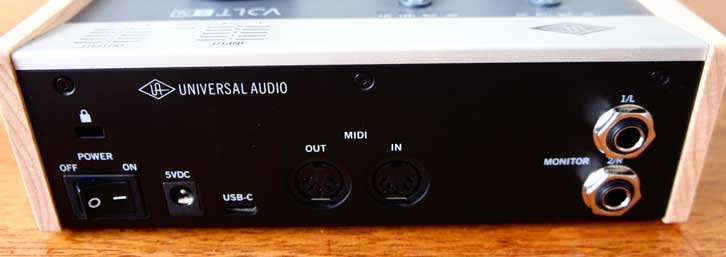
The Universal Audio Volt 276 has the following inputs and outputs:
- 2 XLR/TRS combo jacks for mic, line, or Hi-Z inputs (front)
- 2 1/4-inch TRS balanced outputs
- 1 1/4-inch TRS stereo headphone output (front)
- 1 MIDI I/O
- 1 USB-C port
- 1 12 V power port
Performance
This unit delivers solid technical performance overall. The main output has very capable dynamic range at 110 dB, all the inputs and outputs have low distortion and the preamps have low self-noise.
The headphone output drives high and low-impedance headphones with a good amount of power and low distortion.
The round-trip latency is a bit higher with the Volt 276 compared to rival interfaces. But the direct monitoring button allows you to bypass the signal from your computer so you can hear your performance without latency.
If you need to hear the real-time effects in your monitoring, then you will have to deal with some latency with this machine.
Audio Examples
Strat, DI – UA Volt 276
Spoken Text – UA Volt 276
Verdict
Higher-end, real-time effects processing interfaces like the UA Apollo Solo allow you to bake the sound of your plugins into your recorded tracks.
Although you have fewer options to shape your sound, the Universal Audio Volt 276 offers the option to bake compression and harmonic distortion into your sound without the higher price.
It also is a very well thought-out design and build, giving you full control without the need to fiddle on your computer.
If you’re looking for an affordable interface with built-in compression, solid technical specs, and a no-nonsense setup, look no further.
Motu M4
our rating
4.7
Bottom Line:
An affordable interface with a simple setup and a very competitive technical performance.
Hardware & Software
The Motu M4 is a sturdy, all-metal, 4-in/4-out interface with excellent technical performance for guitar applications.
There is no launch or driver software necessary to get it up and running. Once the firmware is updated, you only need to plug in and load up your DAW. The onboard controls allow you to set levels with the LCD screen, turn direct monitoring on and off, and adjust your input/playback mix all directly from the interface itself.
It is worth noting that the M4 also comes with convenient loopback channels. If you are using a mac you will need to download an additional driver to use the loopback routing functions.
Inputs and Outputs
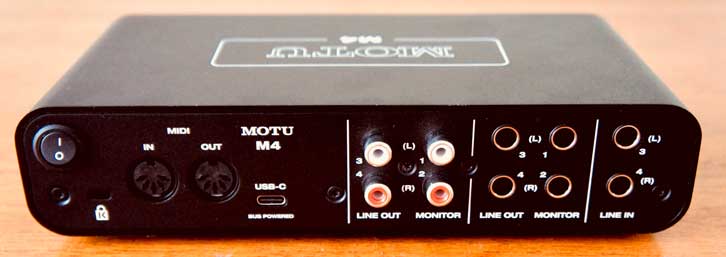
The Motu M4 has the following inputs and outputs:
- 2 1/4-inch line in analogue inputs
- 2 XLR/TRS combo jacks for mic, line or Hi-Z inputs
- 4 1/4-inch TRS balanced outputs
- 4 RCA unbalanced outputs
- 1 1/4-inch TRS stereo headphone output.
- 1 MIDI I/O
- 1 USB-C port
The large software bundle the Motu M4 comes with is mostly just a bunch of three-month trials and a free version of Performer Lite (DAW).
Annoyingly, all of the software needs to be downloaded separately with separate logins. In the end, you don’t have much more than what comes standard with most DAWs.
Performance
Technically, the Motu M4 is up to snuff. It has an impressive dynamic range on the mic inputs (115 dB) and on the main outputs (120 dB), very low self-noise, and low round-trip latency.
With the ‘MON’ button you can directly monitor your performance without latency. Having this option on the interface itself is great for guitar playing. There is no need to pull up the launch software on your computer and no mouse. Just press a button on the interface and play.
The headphone output, driven by ESS converters, drives headphones with a good amount of juice at 12.5 dBu. That’s enough for most high impedance headphones.
Audio Examples
Strat, DI – Motu M4
Spoken Text – Motu M4
Verdict
The Motu M4 has excellent technical performance at this price point. The simple setup where everything (except the loopback channels) can be controlled from the onboard dials and buttons has real benefits for guitar players. Sometimes more fiddling is the last thing you need.
If you’re looking for an affordable machine with a simple setup and excellent overall performance, this is your interface.
See here for our complete review of the Motu M4.
Audient ID4 MKII
our rating For Mixing
4.4
Bottom Line:
Other interfaces on this list have more features but for a simple setup, this is a pretty great unit for the price.
Hardware & Software
The Audient ID4 is a 2-in/2-out capable interface at a very affordable price. The unit has an all-metal housing with metal dials.
In addition to all the standard dials and controls, the interface has a dial for input/daw mix and the ‘ID’ button which allows you directly control knobs and levels in your DAW or in the ID software it comes with. This all worked as it should without problems.
The interface is compatible with IOS but does not have the option of an external power input. This means your iPad or iPhone would have to power the unit, which in most cases is not ideal.
Inputs and Outputs
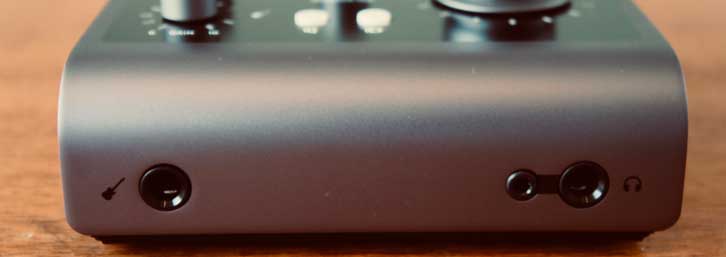
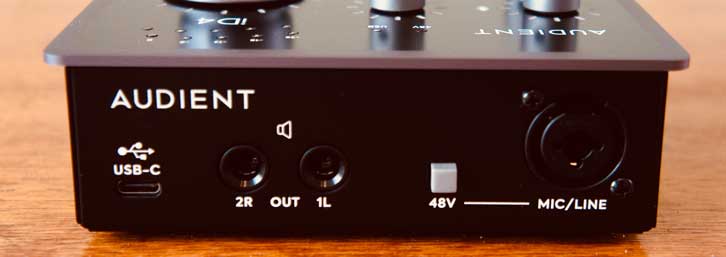
The Audient ID4 has the following inputs and outputs:
- 1 XLR/TRS combo jacks for mic, line, or Hi-Z inputs
- 1 JFET instrument input
- 2 TRS outputs (stereo pair)
- 1 1/4-inch (or 1/8-inch) TRS stereo headphone output
- 1 USB-C port
The included software package includes some decent offers including Cubase but mainly you’re just getting a capable interface in this purchase. The driver software works smoothly and includes two virtual channels for loopback.
Performance
At this price point, the technical performance of this machine is impressive.
The round-trip latency is very low and feels like real-time processing when monitoring through your DAW. It uses high-quality chips for DA/AD converters.
The preamps have a very low noise floor and a very healthy 112 dB of dynamic range.
The headphone amp in this machine can drive high-impedance headphones with ease and very low distortion. On the downside, the output impedance of the ID4 is relatively high so it is recommended to use headphones with at least 80 Ω to avoid frequency response deviations.
Audio Examples
Strat, DI – Audient ID4
Spoken Text – Audient ID4
Verdict
The Audient ID4 is a pretty great unit for the price. It’s generally a plug-and-play setup and all the features work as they should. The interface lacks direct monitoring, but the low round-trip latency means that it will give you pretty reliable monitoring with smaller projects.
Overall, we can recommend this interface if you just want a bare bones setup. At this price point, we preferred the Motu M4 or the Volt 276.
SSL 2+
our rating
4.0
Bottom Line:
Technically adept, premium-quality, planar magnetic headphones with outstanding transient response and full, defined bass. But they will need to be calibrated for mixing.
Hardware & Software
The SSL 2+ is a 2-in/4-out audio interface that offers loads of connectivity, a great build, and solid technical capability for guitar recording.
We loved the build because it’s solid and big enough to set all the levels directly on the interface.
It includes a button for ‘4K’ mode which adds some harmonic overtones to the sound and boosts the high frequencies (similar to the ‘Air’ mode on the Focusrite interfaces or the ‘Vintage’ mode on the UA 276) The effect is baked into the printed sound in your DAW when you use this mode.
Notably, the interface has two headphone outputs with separate dials for gain control onboard.
It’s also worth mentioning that if you don’t need the extra monitor output, extra headphone output, or the MIDI I/O you can get the brother SSL 2 (no plus) for about $100 cheaper.
Inputs and Outputs
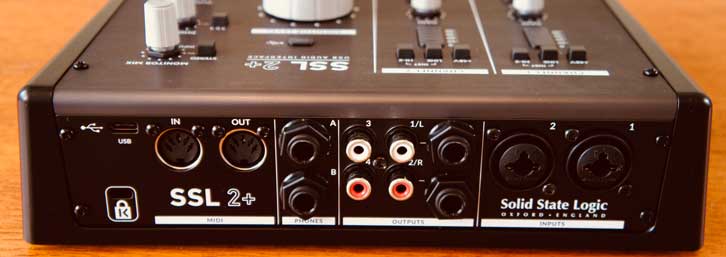
The SSL 2+ has the following inputs and outputs:
- 2 XLR/TRS combo jacks for mic, line, or Hi-Z inputs
- 2 1/4-inch TRS balanced outputs (stereo pair)
- 4 RCA unbalanced outputs (2 stereo pairs)
- 2 1/4-inch TRS stereo headphone outputs (front)
- 1 Midi I/O
- 1 USB-C port
The included software is mostly three-month trials of different plugins and DAWs. This bundle is pretty standard with most interfaces with nothing exceptional on offer.
Performance
The preamps have a healthy dynamic range (around 111 dB) which can support any mic you throw at it and deliver a very low noise floor.
The round-trip latency is about average for interfaces in this class. On the downside, there is no option for direct monitoring on this unit, so if you’re using loads of plugins, it might become difficult to get a monitor signal without delay.
The headphone output drives low and high-impedance headphones easily but gives a small amount of audible distortion if you use low-impedance cans.
Audio Examples
Strat, DI – SSL 2+
Spoken Text – SSL 2+
Verdict
The SSL 2+ has everything a guitarist needs except direct monitoring. Unfortunately, the round-trip latency is about average for its class so you might have some delay issues in the monitoring, especially when using multiple plugins.
That said, it’s still a great build and the preamps offer a warm, clean response. But for the guitarist, it has a hard time offering more than its rivals on this list.
At this price point, we preferred the Motu M4 or the Volt 276.
Antelope Audio Zen Go
our rating
3.5
Bottom Line:
A quality interface with real-time processing and loads of included, high quality plugins. But we think there is better value out there.
Hardware & Software
The Antelope Audio Zen Go Synergy Core is a 4-in/8-out interface (with a long name) that offers premium quality and real-time effects processing. The machine is built entirely of thick metal with a useful LCD screen for setting levels.
Inside the unit, there are three powerful DSP and FPGA chips for real-time processing, quality AD/DA converters, and solid preamps.
The two headphone ports on the front of the interface can be set individually with different levels and different mixes. The two S/PDIF ports on the back allow for an additional two channels.
Inputs and Outputs
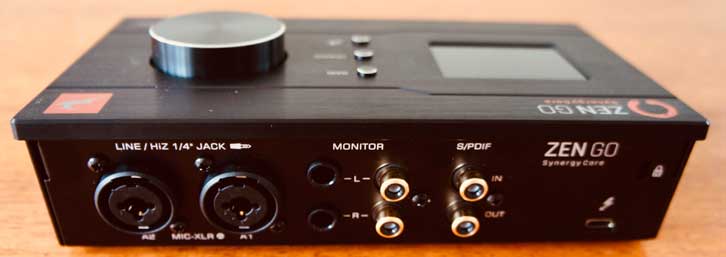
The Antelope Audio Zen Go Synergy Core has the following inputs and outputs:
- 2 XLR/TRS combo jacks for mic, line, or Hi-Z inputs
- 2 1/4-inch TRS balanced outputs (stereo pair)
- 2 RCA unbalanced outputs (stereo pair)
- 2 1/4-inch TRS stereo headphone outputs (front)
- 2 S/PDIF ports
- 1 USB-C/Thunderbolt 3 port
The real benefits of this interface are the included software and the fact that all of this software can be applied with real-time, near-zero latency monitoring.
You’re getting a fantastic range of plugins including guitar cabinets and amps, compressors, preamps, and reverb. These are all high-quality plugins.
That said, the setup process is particularly lengthy and not straightforward. Considering the amount of routing and effects fiddling to learn here, Antelope does not provide enough info or tutorials on their site.
Performance
The technical performance of the Zen Go is overall good, but it could be better considering the price of this unit.
The main disappointment is the preamps. They are powerful but they could be cleaner. Unfortunately, the noise floor is higher than most on this list and they deliver a small amount of hiss.
On the plus side, the main output gives a healthy amount of gain with very little distortion. There is also very low distortion on the line inputs, and headphone outputs.
And the headphone outputs can easily drive high-impedance headphones. With this unit, due to a higher output impedance (27 Ω), it is recommended to use headphones with an impedance higher than 160Ω to avoid any variance in frequency response.
Audio Examples
Strat, DI – Antelope Audio Zen Go
Spoken Text – Antelope Audio Zen Go
Verdict
Being the most expensive unit on this list, we expected a lot from the Antelope Audio Zen Go. It does deliver in most categories especially, the real-time effects processing that can be applied to the wide range of included plugins including guitar cabinets, amps, preamps, compressors and EQ.
The technical performance is great except for the audible noise floor on the preamps.
Also, the amount of fiddling to get setup with this machine can be tiresome. The launch software has loads of options but could be more intuitive.
Overall, this is a quality interface but there’s better value out there. If you’re looking for a machine with comparable features, something like the Universal Audio Apollo Twin X is definitely a better option.
Frequently Asked Questions
What’s the best way to connect a guitar to an audio interface?
If you’re plugging your amp directly into your audio interface via a combo input (one that accepts XLR, TRS, and TS connections) turn the gain on the interface to zero, this will prevent any damage to your preamps. Your amp is sending a line-level signal that could damage the preamps of the combo input.
Can I connect an amp head to an audio interface?
Yes. But be careful! If you’re connecting an amp head, it must remain connected to your speaker cab or you could blow the amp. The amp head will draw too much current and blow out the circuit if it has nowhere to send the electrical signal.
What’s the difference between the ‘Line out’ output and the ‘Speaker’ output?
Line out and speaker output is altogether different. Line out is a line-level signal with enough dB for processing.
Speaker outputs are amplified line-level signals, also known as speaker-level signals. They are much louder, with a higher voltage than your line-level signal. If a speaker-level signal is sent to your audio interface, it could very well result in damage.
How do I get the sound of my amp into my DAW?
You’re not going to get the sound you hear from your amp by plugging the line-out into your interface. The speaker cabinet has its own color. If you want to include that, record it with a mic. A Shure SM57 is a good mic to start with for this application.
Questions or Comments?
Join the discussion here on Facebook.